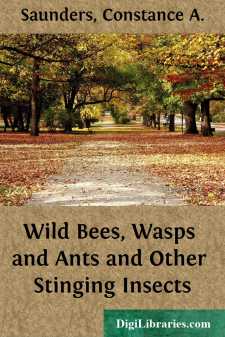Categories
- Antiques & Collectibles 13
- Architecture 36
- Art 48
- Bibles 22
- Biography & Autobiography 813
- Body, Mind & Spirit 142
- Business & Economics 28
- Children's Books 17
- Children's Fiction 14
- Computers 4
- Cooking 94
- Crafts & Hobbies 4
- Drama 346
- Education 46
- Family & Relationships 57
- Fiction 11829
- Games 19
- Gardening 17
- Health & Fitness 34
- History 1377
- House & Home 1
- Humor 147
- Juvenile Fiction 1873
- Juvenile Nonfiction 202
- Language Arts & Disciplines 88
- Law 16
- Literary Collections 686
- Literary Criticism 179
- Mathematics 13
- Medical 41
- Music 40
- Nature 179
- Non-Classifiable 1768
- Performing Arts 7
- Periodicals 1453
- Philosophy 64
- Photography 2
- Poetry 896
- Political Science 203
- Psychology 42
- Reference 154
- Religion 513
- Science 126
- Self-Help 84
- Social Science 81
- Sports & Recreation 34
- Study Aids 3
- Technology & Engineering 59
- Transportation 23
- Travel 463
- True Crime 29
Wild Bees, Wasps and Ants and Other Stinging Insects
Description:
Excerpt
THE SUBJECT IN GENERAL
I think I ought here to say why I propose to limit myself to an account of a certain portion only of the Hymenoptera. The reason for this, in the first place, is that the section which I have selected is the only one of which I have any special knowledge; it consists of the bees, wasps, ants and sandwasps, four groups which make up the stinging section of the order—or perhaps more accurately, which have poison bags connected with their egg-laying apparatus or ovipositor. Another reason for their selection lies in their nesting habits; these enable one to get a further insight into their economy and ways than can be obtained from those of almost any other group or order—at any rate they make them comparatively easy to study; one can, so to say, find these little creatures at home, whereas in most orders there seems to be no definite home to which the individuals may be traced; a great advantage also in selecting the stinging groups for study is that they are creatures of the spring and summer, and of the sunshine, so that the weather which tempts them out to their duties is of the kind most agreeable to those who wish to investigate their habits.
The habits of the hive bee have not been touched on, as so many excellent treatises have been written on them that any observations here would be superfluous.
Although these groups are distinguished by their stinging habits, it is only the female that possesses a sting—the male is a most harmless creature and quite incapable of injuring any one. A male wasp or even a male hornet may be handled with absolute impunity, only it is wise to be certain as to the sex of the individual before presuming to play with it too much! A word here may perhaps be said about stinging. People often talk about a gnat stinging or a stinging fly; it may be difficult to define exactly what "to sting" means, but the writer has always considered that a sting is inflicted by the tail end of the creature or a bite by the mouth. A fly or gnat no doubt inserts its proboscis into one's flesh just as a wasp does its sting; but the actions of such opposite parts of the body surely demand distinct names. As we have been alluding to flies it may not be inappropriate to say here that all the creatures we are going to consider have four membranous wings except the worker ants and a very few forms which are comparatively seldom met with. By this character they may at once be known from flies, which have only two membranous wings. The large brown "drone flies", so often seen on the windows of our rooms, especially in autumn, and which most people mistake for hive bees, to which they certainly bear a considerable general resemblance, may be detected at once by wanting the two hind wings of the bee.
The "aculeate", or stinging, Hymenoptera, are divided into sections and families according to their structure; but the groups which stand out most clearly in regard to their habits are the solitary and social species, the predaceous and non-predaceous and the inquilines or cuckoos....


